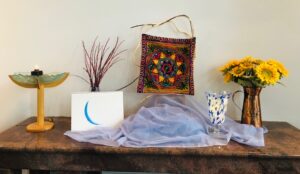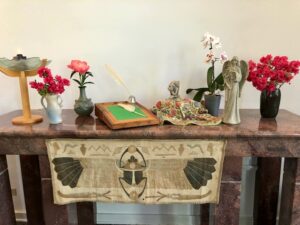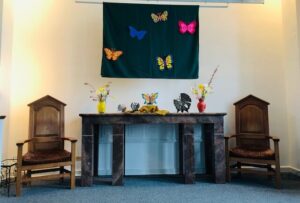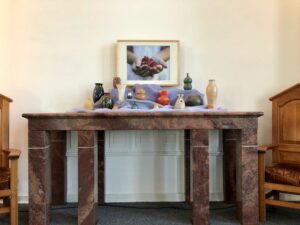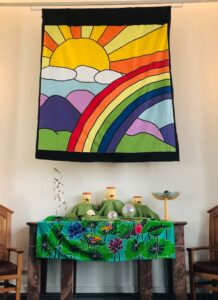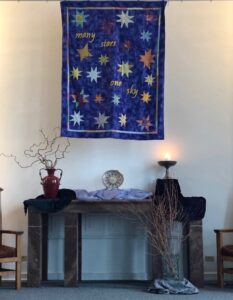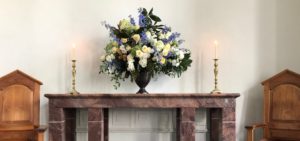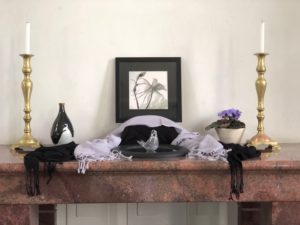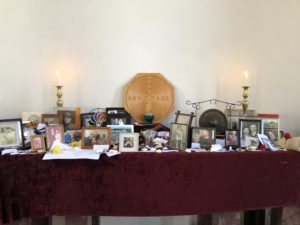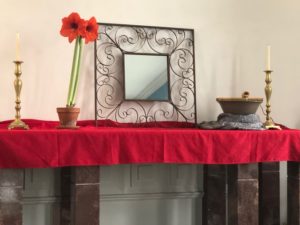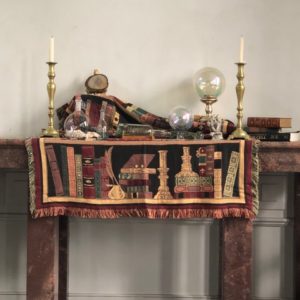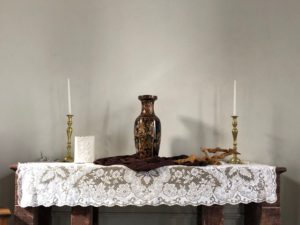Rev. Jamie McReynolds led this service.
During this transitional time in the life of TJMC, this congregation can choose how to be in community. How shall we contribute to increasing the amount of belonging or relatedness that exists in the world?
Abundant Community
It was the coldest winter ever. Many animals died because of the cold. The porcupines, realizing the situation, decided to group together to keep warm. This way they covered and protected themselves; but the quills of each one wounded their closest companions.
After a while, they decided to distance themselves one from the other and they began to die, alone and frozen. So they had to make a choice: either accept the quills of their companions or disappear from the Earth. Wisely, they decided to go back to being together. They learned to live with the little wounds caused by the close relationship with their companions in order to receive the warmth that came from the others. This way they were able to survive.
I just shared The Fable of Porcupines, by the German philosopher Arthur Schopenhauer. I don’t need to tell you that being in community can be hard, it can get a bit “prickly”. Is anyone here living with the little wounds from close relationships in this or another community?
When Rev. Alex invited me to lead worship today, I thought about the struggles TJMC has been through–both most recently, with the transition in ministerial leadership, and during the six years I was a member here – from 2011 until moving to Blacksburg two years ago. I have deep ties to this congregation.
As a community minister, I worked both as a hospital and hospice chaplain. But lately, my ministry has been focused on building community, both at the UU congregation in Blacksburg, where my partner Pam is the settled minister, and the communities of the New River Valley and southern Virginia. Community is important to me.
The TJMC covenant speaks to creating the beloved community we desire.
The covenant reads:
In order to create the beloved community we all desire for ourselves, we, the Congregation of TJMC Unitarian Universalist, covenant to:
• Communicate with compassion and respect, especially when we disagree;
• Celebrate diversity and nurture our inclusivity;
• Embrace one another spiritually and emotionally;
• Promote social justice within our congregation and the larger community;
• Generously support the ministries of the church with time, money and enthusiasm; and
• When we have fallen short, lovingly call each other back into covenant.
That is a very important last line. When the covenant was being developed, there was pushback on the wording of the last line of the covenant. Some people thought it should say ‘if we have fallen short,’ rather than ‘when we have fallen short.’
Falling short is part of being human.
The term ‘Beloved community’ has become somewhat cliché. The term was coined by the 19th century philosopher Josiah Royce, who maintained “that only the Christian model of the loyal community successfully combines the true spirit of universal interpretation with an appreciation of the “infinite worth” of the individual as a unique member of the ideal Beloved Community, the Kingdom of Heaven (Royce 2001 [1913], 193). The term was made famous by Rev. Dr. MLK during the civil rights movement. Building the beloved community is a global vision that we can practice here and take out to all the other communities we are members of. Building community is an ongoing process.
Over the past twenty-five years, I’ve experienced varying depths of community in five different UU congregations. Author M. Scott Peck says in his book, A Different Drum: Community Making and Peace:
“If we are going to use the word [community] meaningfully, we must restrict it to a group of individuals who have learned how to communicate honestly with each other, whose relationships go deeper than their masks of composure, and who have developed some significant commitment to “rejoice together, mourn together,” to “delight in each other, make others’ conditions our own.”
According to Peck, any group of strangers coming together to create a community goes through four distinct and predictable phases: pseudo-community, chaos, emptiness and, finally, true community. Now you may be thinking, “but we aren’t a group of strangers!” That is true, and, as a congregation of 400 members, you can’t know everyone, so I think Peck’s stages can be useful.
Like most, if not all congregations, TJMC is a community made up of smaller groups which are also communities. Some of these groups are fluid, which means that they function at times as pseudo-communities, a few might function as true communities, and from time to time communities are in the chaos or the emptiness stage.
In the first stage, pseudo-community, a group avoids conflict, ignoring or minimizing individual differences. In the interest of functioning smoothly, individuality, intimacy and honesty are discouraged. I think of the social hour. Generalizations and platitudes are common. My men’s group often seems like a pseudo-community, and at times we would touch true community.
Once differences arise, as they inevitably do, the group moves into the second stage–chaos . “The chaos centers around well-intentioned but misguided attempts to heal and convert. The group will often try to smooth over differences. This stage often involves uncreative and unconstructive fighting and struggle.” For example, each year the church board forms a new community and has to work through individual differences, which means each year they have to go through the chaos stage.
Getting to true community requires going through the third stage– emptiness, the most difficult and crucial stage. Emptiness means letting go of our ego, our tendency to insist, as Frank Sinatra sings, ‘I did it my way.’ in this stage, members must overcome expectations and preconceptions; prejudices; ideology, theology and solutions; the need to heal, fix, convert or solve; and the need to control. The stage of emptiness is ushered in as members begin to share their own brokenness–their defeats, failures, fears–rather than acting as if they “have it all together.”
In the fourth stage, “The transformation of the group from a collection of individuals into true community requires surrendering some of our individuality for the sake of community. This can be challenging in a culture that prizes rugged individualism. Through this sacrifice of some of our individuality, comes true community. Members begin to speak of their deepest and most vulnerable parts–and others will simply listen. There will be tears–of sorrow, of joy. An extraordinary amount of healing begins to occur. True communities are always reaching to extend themselves, to be more inclusive.
These stages of community – pseudo-community, chaos, emptiness and finally, true community–apply to each of the smaller communities within TJMC. Each of the committees and small groups in this congregation, is a community. TJMC is a community of communities. Think about one of the smaller communities here to which you belong. Which stage is it in? Has it passed through one or more of the stages? Is it stuck in a stage? What could you do to help it move into true community?
At this year’s General Assembly, Paula Cole Jones gave the Sophia Fahs lecture – Building A Community of Communities. Some of you know Paula from her work with TJMC. She issued a call for systemic change – an identity change for UUs. Specifically, she called for changing the metaphor for our congregational identity from a family, the dominant cultural paradigm, to seeing ourselves as a community of communities – a multicultural paradigm. Families focus on individuals, have a pecking order, and everyone knows where the authority is. It is implicit whom you can bring home. Communities, on the other hand, focus on self-growth and self-direction as a whole, rather than as individuals. These principles have historically been used by the marginalized communities to strengthen identity. Churches already have many communities, we call them committees and small groups. Seeing ourselves as a community of communities creates the possibility of a different future and it is key to building Beloved Community.
Each of you have your reasons for participating at TJMC. A fundamental reason for being in community is to meet our need for belonging–to be related to and a part of something. Building community, not only at TJMC, but beyond these walls, increases the amount of belonging or relatedness in the world. We are in dire need of more relatedness. You know this all too well in Charlottesville from the alt-right rally two years ago, and the ripples that continue to be felt in this community. To belong can also mean being an owner, as in something belongs to me. Belonging to a community carries the responsibilities of ownership.
Several years ago at General Assembly, Rev. Ken Hurto, from the UUA Southern Region Congregational Life Staff, led a workshop about community building. He recommended a book by Peter Block, Community: The Structure of Belonging, which you can probably tell from the title, makes the case that there are structural ways to create the experience of belonging. During this leadership transition, this congregation has an opportunity to create a future that is not just an improvement, but one of a different nature from the one you now have. Or not. The choice is yours. Who am I to be telling you that you need to create a new future? I ask you to hear me out and see what you think.
For starters, we have to shift the focus to the possibility of community instead of the problems of community. We also need to shift the narrative by coming together in ways that model the future we desire. And I say we, because even though I am no longer a member of TJMC, these same ideas apply to the UU Congregation in Blacksburg and the other communities to which we belong. Block says, “The hard part of building community is that it is always a custom job. It is born of local people, with unique gifts, deciding what to create together in this place.” Rev. Wik coined the term worship weavers and promoted the idea that we are all ministers. Today, I’m proposing that we can all be community weavers.
Block also writes,“By thinking in terms of a structure of belonging, we begin to build the capacity to transform our communities into ones that work for all.” We are increasing social capital, our quality of relationship and cohesion that exists among us. He differentiates between bonding social capital and bridging social capital. “Bonding social capital comprises the networks that are inward looking, composed of people of like mind.” [Block 476] We see this in the increasing polarization and tribalism in our politics and culture. Bridging social capital encompasses networks of different types of people and tends to be outward looking. I helped develop the last strategic plan for TJMC, five years ago or so, and we were surprised by the feedback that we needed to focus on in-reach instead of outreach. With the recent conflicts, I’m hearing that is still true.
Building abundant community involves focusing on possibility, generosity and gifts, rather than problem-solving, fear and retribution. Focusing on generosity and gifts are common themes in the UU congregations I’ve been a member of. Focusing on possibility rather than problem-solving is unfamiliar.
Another one of Block’s ideas that stood out to me, is the difference between retributive community and restorative community. A retributive community focuses on fear and blame, emphasizes more laws and oversight, romanticizes leadership [and strong leaders], and marginalizes hope and possibility. Block says, “In the retributive culture, cynicism is the norm and becomes the lead story. Cynicism justifies retribution. Retribution is fueled by cynicism.” Sounds all too familiar from what we’re seeing on the national stage.
In contrast, a restorative community extracts the power out of the current story and produces a new collective story based upon possibility, generosity and accountability. There is a focus on the language of connection and relatedness and belonging. “What do we want to create together?” is a key question. Rather than asking ‘how do we solve this problem?’, we ask ‘what is the possibility we want to live into?’ Our mindset shifts from valuing what is efficient to valuing belonging. [share my struggles at General Assembly with efficiency vs belonging] Rather than looking to a strong leader, the members of the community become accountable for the possibility of the community they choose to live into. People will be accountable and committed to what they have a hand in creating. Being accountable reminds me of the famous JFK quote, slightly modified “Ask not what your community can do for you, ask what you can do for your community.” Restoration is about healing our woundedness – healing our fragmentation and incivility. As in the fable of the porcupines – we learn to live with the minor wounds from close relationship with our companions. BECAUSE IT IS WORTH IT.
How do we heal this woundedness? We start in our smaller communities – our groups and committees. Small groups are the unit of transformation. Living into the possibility of an alternative future happens every time we gather together – in each invitation we make, each relationship we engage in, and each meeting we attend. The conversations we engage in are key. Block says “Transformation occurs when we invite people into conversations that ask them to act as creators or owners of community.” [Block xxx] We invite everyone to be community weavers. Not everyone will accept the invitation, and that’s perfectly fine, it needs to be voluntary. We invite people to experience intimate and authentic relatedness.
Now the core task of leaders is to create the conditions for congregational engagement, by convening gatherings, naming questions and most importantly, listening. These conversations create trust, accountability and connection. The focus is on: communal possibility, taking ownership, allowing space for diverse and dissenting opinions, and the willingness to make unconditional commitments. A commitment that is entered into conditionally is a barter, not a commitment. The questions are carefully constructed to cause people to become an actor as soon as they answer them. Some examples of powerful questions are:
• Why was it important for you to show up today?
• What is the crossroads you face at this stage of the game? Not we, you!
• What is the story you keep telling about the problems of this community?
“Answering these kinds of questions helps us become more accountable, more committed, more vulnerable.” By sharing our answers with each other, we grow more intimate and connected. We move closer to being in true community.
I’ll close today with a story told by David Brooks in his book, A Second Mountain.
Ruthie was a teacher who lived in a small town in Louisiana, one of those people who radiate an inner light. Tragically, she died of cancer at forty. More than 1,000 people came to her funeral. Ruthie loved to go barefoot, so the pallbearers, from the local fire department where her husband Rod worked, carried her casket to the grave, barefoot.
Ruthie always thought the dead of her town should be remembered on Christmas, so she created a tradition. Every Christmas Eve she would go to the town cemetery and put a lit candle on each gravestone. Ruthie happened to die just before Christmas, and as the family was sitting around on Christmas Eve, Rod asked his mother if she would like to do what Ruthie used to do – to light a candle on each gravestone. His mother replied that maybe in other years that would be good, but this year it was just too tough.
That evening Rod’s parents attended mass and drove home, early evening, by the cemetery. They looked over and gasped. There were hundreds of lights. Somebody else had put a candle on every gravestone.
That’s how community works. Somebody starts something. A new tradition is established. Other people step in and carry it on.
We can all be that somebody. We can take a stand for the possibility of abundant community–One that is composed of people who are vulnerable with each other, who are not afraid to face the difficulties, who are willing to let go of ego for the sake of the whole, who focus on the possibilities instead of the problems, who face not just inward, but also outward.
We can all be community weavers.

